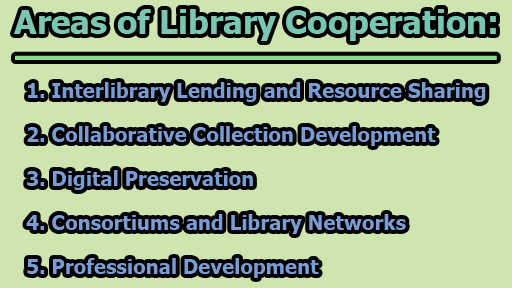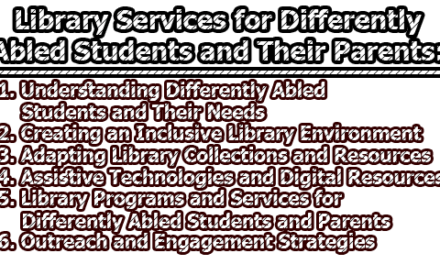Areas of Library Cooperation: Enhancing Access, Resources, and Services
Library cooperation is a fundamental concept in the field of library and information science, emphasizing collaboration and resource sharing among libraries to enhance access to information, improve the quality of services, and maximize the utilization of resources. In an era marked by rapid technological advancements and changing user expectations, libraries face numerous challenges in meeting the diverse needs of their patrons. To address these challenges effectively, libraries across the world have recognized the importance of cooperation, which allows them to pool their resources, expertise, and collections. Here, we will discuss the key areas of library cooperation: Enhancing Access, Resources, and Services; including interlibrary lending and resource sharing, collaborative collection development, digital preservation, consortiums and library networks, and professional development.
- Interlibrary Lending and Resource Sharing: Interlibrary lending and resource sharing are vital components of library cooperation that play a crucial role in expanding access to information resources. These activities involve libraries sharing their collections, including books, journals, and other materials, with other institutions to benefit patrons who might not otherwise have access to these resources.
Interlibrary lending often takes place through resource-sharing networks, consortia, and regional library systems. Libraries join these networks to share materials efficiently and cost-effectively. Such cooperation enables libraries to make the best use of their budgets while ensuring that patrons have access to a wider array of resources. For instance, a small community library might not be able to afford subscriptions to all the academic journals its patrons need, but through interlibrary lending, it can obtain articles from partner libraries.
Resource sharing offers several benefits, including increased access to specialized materials, cost savings, and improved user satisfaction. However, it also presents challenges related to copyright compliance, differing lending policies among libraries, and the logistics of transporting materials between institutions (Kennedy, 2017).
- Collaborative Collection Development: Collaborative collection development involves multiple libraries working together to build comprehensive and efficient collections. This strategy is particularly relevant in an era when library budgets are often constrained, and the cost of acquiring and maintaining materials is rising.
Cooperative collection development takes various forms, such as consortial purchasing agreements, joint collection development policies, and shared electronic resources. Consortia, in particular, are effective mechanisms for libraries to pool their resources and negotiate favorable terms with publishers and vendors. By coordinating their purchasing efforts, libraries can secure better deals on electronic databases, e-books, and other digital resources (Scheeder, 2019).
The benefits of collaborative collection development include access to a broader range of materials, cost savings, and the ability to leverage the expertise of multiple libraries when selecting resources. However, it can also pose challenges related to decision-making processes, resource allocation, and ensuring that the collection meets the diverse needs of all participating institutions (Havemann, 2020).
- Digital Preservation: Digital preservation is a critical aspect of library cooperation, given the increasing reliance on digital resources and the need to ensure their long-term accessibility. Libraries cooperate in various ways to address the challenges of preserving digital materials, including digitized collections, born-digital content, and electronic theses and dissertations.
Cooperative digital preservation initiatives often involve multiple libraries contributing to the creation of digital repositories, such as the Digital Public Library of America (DPLA) or HathiTrust. These repositories serve as central hubs for archiving and providing access to digital content. Libraries contribute their digitized materials to these repositories, benefiting from shared infrastructure, expertise, and long-term preservation strategies (Skinner, 2019).
Digital preservation efforts are essential for safeguarding cultural heritage, ensuring the accessibility of scholarly works, and mitigating the risks associated with format obsolescence and data loss. However, they require sustained collaboration, technical expertise, and financial resources to be effective.
- Consortiums and Library Networks: Consortiums and library networks are formal organizations established to facilitate collaboration and resource sharing among member libraries. These entities come in various forms, such as statewide library consortia, regional library networks, and subject-specific groups. Their primary purpose is to enhance the capabilities and services of member libraries by promoting cooperation.
Consortiums and networks offer several advantages, including collective purchasing power, shared technology infrastructure, and opportunities for professional development and training. They also provide a platform for libraries to advocate collectively for policy changes, funding, and other issues affecting the library community (Lee, 2018).
One notable example is the OhioLINK consortium, which connects academic libraries across the state of Ohio. Through OhioLINK, member libraries share resources, collaborate on digital initiatives, and provide access to a vast collection of electronic resources, benefiting students, faculty, and researchers across the state.
However, consortiums and networks can encounter challenges related to governance, funding, and differing priorities among member institutions. Effective leadership and communication are essential to ensure that the interests of all members are considered.
- Professional Development: Professional development is a crucial area of library cooperation that supports the continuous growth and skill development of library staff. Collaboration in professional development takes various forms, including workshops, conferences, training programs, and mentoring initiatives.
Library associations, both at the national and international levels, often play a significant role in coordinating and providing professional development opportunities. These associations offer conferences where library professionals can exchange ideas, learn about new trends and technologies, and engage in networking. Additionally, they offer webinars, online courses, and publications that contribute to the ongoing education of library staff (Lorenzen, 2020).
Professional development through cooperation ensures that library staff remain up-to-date with emerging technologies and best practices. It also fosters a sense of community and shared purpose among librarians, encouraging the exchange of knowledge and expertise.
In conclusion, library cooperation is a multifaceted concept that encompasses various areas of collaboration, all aimed at improving access to information, optimizing resource utilization, and enhancing the quality of library services. Through interlibrary lending and resource sharing, libraries extend their reach and make a broader range of materials available to their patrons. Collaborative collection development allows libraries to maximize their budgets and expertise to build comprehensive collections. Digital preservation initiatives ensure the long-term accessibility of digital materials. Consortiums and library networks facilitate resource sharing and advocacy, while professional development opportunities support the continuous growth of library staff.
While library cooperation offers numerous benefits, it also presents challenges, including legal and logistical hurdles, resource allocation dilemmas, and governance issues. Effective communication, shared vision, and strong leadership are essential to overcoming these challenges and ensuring the success of cooperative endeavors.
In a rapidly evolving information landscape, libraries must continue to adapt and find innovative ways to collaborate. By embracing library cooperation in its various forms, libraries can better serve their communities, enhance their impact, and remain vital institutions in the digital age.
References:
- Havemann, L. (2020). Collaborative collection development: A systematic review. College & Research Libraries, 81(6), 874-890.
- Kennedy, M. R. (2017). Resource sharing and interlibrary loan: A bibliometric analysis of recent trends. Journal of Access Services, 14(3), 123-135.
- Lee, D. K. (2018). Library consortia and networks: A critical review. The Serials Librarian, 74(1-4), 115-128.
- Lorenzen, M. (2020). Professional development in libraries: A review of literature. Library Leadership & Management, 34(4), 1-15.
- Scheeder, G. (2019). Collaborative collection development and resource sharing in the digital age. Collection Management, 44(3-4), 238-248.
- Skinner, K. (2019). Libraries and the digital world: New collaborations and partnerships. Library Hi Tech, 37(3), 392-404.

Assistant Teacher at Zinzira Pir Mohammad Pilot School and College










